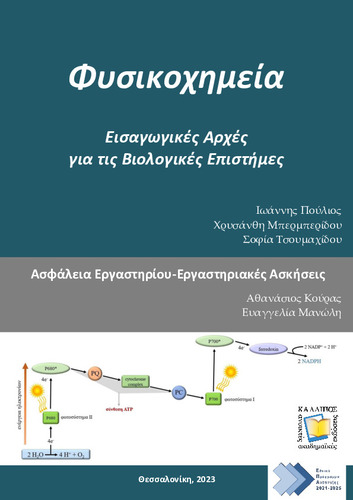| Title Details: | |
|
Physical Chemistry |
|
| Other Titles: |
An Introduction to the Biological Sciences |
| Authors: |
Poulios, Ioannis Berberidou, Chrysanthi Tsoumachidou, Spfia Kouras, Athanasios Manoli, Evaggelia |
| Reviewer: |
Zisi, Christiana |
| Subject: | NATURAL SCIENCES AND AGRICULTURAL SCIENCES > PHYSICS > INDERDISCIPLINARY PHYSICS AND RELATED AREAS OF SCIENCE AND TECHNOLOGY > PHYSICAL CHEMISTRY NATURAL SCIENCES AND AGRICULTURAL SCIENCES > PHYSICS > INDERDISCIPLINARY PHYSICS AND RELATED AREAS OF SCIENCE AND TECHNOLOGY > BIOLOGICAL AND MEDICAL PHYSICS NATURAL SCIENCES AND AGRICULTURAL SCIENCES > CHEMISTRY NATURAL SCIENCES AND AGRICULTURAL SCIENCES > CHEMISTRY > ANALYTICAL CHEMISTRY > CHEMICAL EQUILIBRIUM NATURAL SCIENCES AND AGRICULTURAL SCIENCES > CHEMISTRY > INORGANIC CHEMISTRY > COLLOID CHEMISTRY NATURAL SCIENCES AND AGRICULTURAL SCIENCES > CHEMISTRY > PHYSICAL CHEMISTRY > CHEMICAL KINETICS NATURAL SCIENCES AND AGRICULTURAL SCIENCES > CHEMISTRY > PHYSICAL CHEMISTRY > BIOPHYSICAL CHEMISTRY |
| Keywords: |
Physical Chemistry
Chemical Kinetics Electrochemistry Acid-Base Equilibria Photochemistry Thermodynamics |
| Description: | |
| Abstract: |
This textbook is an introduction to the most important chapters of Physical Chemistry, and it is a part of various lectures in the first semester of the undergraduate program in the Biology Department of Aristotle University of Thessaloniki (AUTH).
Biology is the study of living creatures/organisms, and, its historical origin is descriptive in its nature (taxonomy and description of the species). Through contemporary Biology, however, scientists attempt to understand the phenomena in living creatures on a molecular level. In this way, Contemporary Biology is being transformed from a qualitative to a quantitative science, and as a result of this, a theoretical framework, corresponding to the mathematical approach, is required. Physical Chemistry as a part of the science of Chemistry can provide an important framework in this infrastructure as well as in the study of molecular science, the characteristics of living creatures, and the chemical and biological reactions taking place. Even though Physical Chemistry is mainly an educational tool for the chemists, its terms can also be used for the understanding of various and important mathematical processes, with the minimum background of mathematical knowledge needed.
Physical chemistry studies the molecular structure of macroscopic appearing material as well as its effect on individual properties. In chemical systems, it investigates and analyses various phenomena, such as chemical reactions, energy changes etc., while the biological phenomena, such as enzymatic reactions, photosynthesis, electrolyte transport etc., can be researched and understood with the help of physical chemistry laws.
In this textbook, a reference to the major areas of Quantum Theory, Statistical Thermodynamics and Spectroscopy is not made, as the text is addressed to first-semester undergraduate students.
The present textbook consists of ten chapters. In the first eight chapters, an introduction to theoretical terms is given, while the last two chapters refer to several selected laboratory exercises, and to o the health and safety regulations needed while performing them. All chapters are accompanied with exercises, math problems, bibliography and a brief table of the foremost terms and mathematical equations.
|
| Linguistic Editors: |
Kostopoulos, Aristotelis |
| Graphic Editors: |
Madamas, Sotirios |
| Type: |
Undergraduate textbook |
| Creation Date: | 17-10-2023 |
| Item Details: | |
| ISBN |
978-618-228-120-8 |
| License: |
Attribution - NonCommercial - ShareAlike 4.0 International (CC BY-NC-SA 4.0) |
| DOI | http://dx.doi.org/10.57713/kallipos-355 |
| Handle | http://hdl.handle.net/11419/10906 |
| Bibliographic Reference: | Poulios, I., Berberidou, C., Tsoumachidou, S., Kouras, A., & Manoli, E. (2023). Physical Chemistry [Undergraduate textbook]. Kallipos, Open Academic Editions. https://dx.doi.org/10.57713/kallipos-355 |
| Language: |
Greek |
| Consists of: |
1. The gas and liquid state 2. Thermodynamics 3. Chemical Equilibrium 4. Phase Equilibria of Nonelectrolyte Solutions 5. Electrolytic Solutions-Galvanic Cells 6. Elementary Reaction Kinetics 7. Acid-Bases-Salts 8. Photochemistry 9. Safety regulations in the Chemistry Laboratory 10. Physical Chemistry Laboratory Exercises |
| Number of pages |
346 |
| Publication Origin: |
Kallipos, Open Academic Editions |
| You can also view | |
| User comments | |
There are no published comments available! | |

